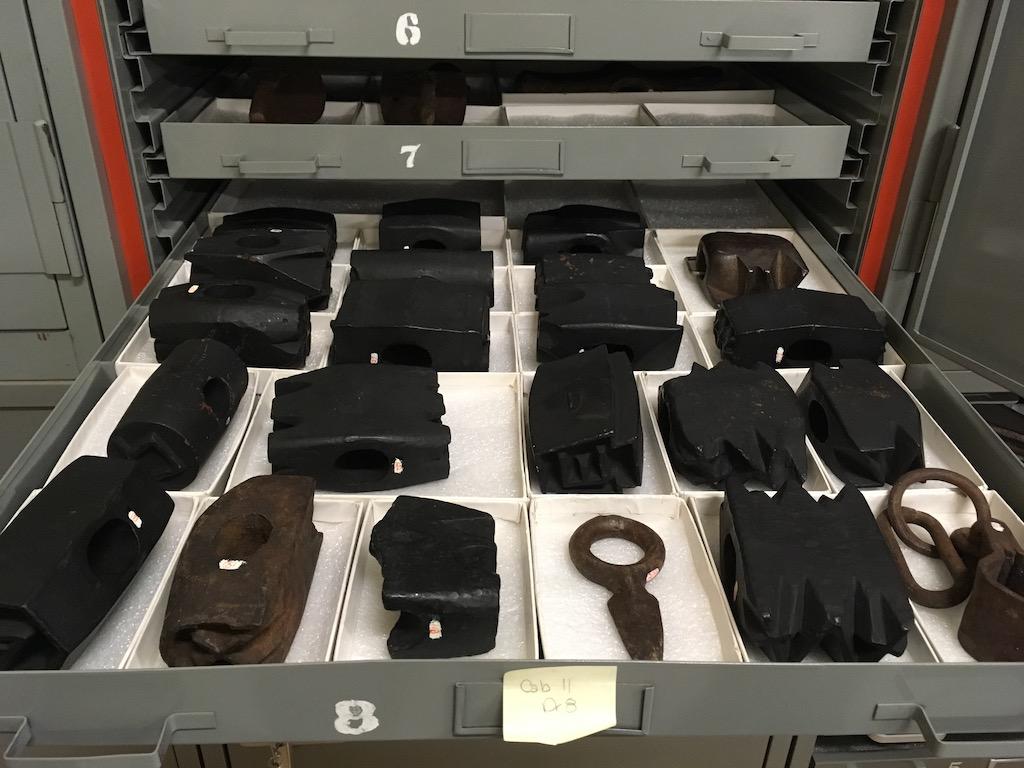A drawer of 'logging marks' tells some of the history of Voyageurs National Park.
By Ed Heimel
Nestled against the Rainy River, just a stone’s throw from the Canadian border, the archives at Voyageurs National Park in northern Minnesota hold a treasure trove of logging marks. Twenty-seven cast iron marks rest in two drawers, a relic of a bygone era in lumbering.
Logging marks, similar in concept to cattle brands, were used to identify the person or company that cut the trees in northern forests. Marks were affixed by means of a heavy stamp hammer with a cast iron stamp at the end, with a long handle like an ax, and weighed four to five pounds. The stamp had raised letters of the log mark or brand. The indentation was less than an inch deep, but with the use of the hammer, the compression of the wood fibers impressed the mark for several inches into the butt of the log. The end mark was stamped 3-4 times in different positions so the mark was easily visible from all directions.
Logging marks had ancient roots in Europe, but in more recent times were brought to the forests of the Midwest by loggers from Maine and New Hampshire as their tree supply diminished and the loggers followed new sources of tall trees, especially the highly prized white pine.
In Minnesota, logging marks had to be registered with the state, according to a law passed in 1858. Marks could be of one’s own design or created by the state office. Mroe than 20,000 marks were registered in Minnesota. Some companies would have multiple marks, recognizing different areas being logged or their takeover of older logging companies. By the 1920s, few new log marks were being registered.
In northernmost Minnesota, logging came late. While the grand Mississippi River was used to send logs downriver to Minneapolis and other milling centers, there is a large swath of the northern portion of Minnesota where the rivers flow north into Hudson’s Bay in Canada. Early logs were destined for Canadian mills until a mill was constructed along the Rainy River in International Falls in 1910.

One of the cast iron logging marks used in the forests now within Voyageurs National Park.
Logging in the area now covered by Voyageurs National Park increased after railroads finally made it into northern Minnesota. Before railroads, trees cut in winter were hauled on huge sleds pulled by horses. Cut logs were stacked at the edge of rivers and, come spring thaw, floated downriver. Logs were stored at boom sites, areas along the river where the logs were sorted and then gathered into large rafts, and floated to their final mill destination.
When one visits Voyageurs, you can visit Hoist Bay, where logs were transferred from land to railroad cars and transported south to Virginia, Minnesota. Here the world’s largest sawmill at the time made short work cutting the millions of board feet of white pine harvested each year and directed it to the larger U.S. market. Those days are long gone, as the mill closed in 1929 as forests disappeared through clear-cutting. But the story of Minnesota and Midwest forest disappearance is a tale for another day.
As in most national parks, staffing at Voyageurs is tight, but archivist Catherine Crawford may be able to provide a glimpse of these long forgotten logging marks if you call in advance to determine her availability.
Traveler postscript: For more on logging history in today's Voyageurs National Park, read this 1986 Special History Study On Logging And Lumbering Associated With The Area Now Incorporated Within The Voyageurs National Park by David Fritz of the National Park Service.
Also, The Logging Era at Voyageurs National Park, Historic Contexts And Property Types by Barbara Wyatt.
Ed Heimel and his wife Christine Klejbuk travel extensively through the National Park System and into state parks. They document their trips at ckeh.wordpress.com. In October of 2019, they spent the month volunteering at Voyageurs National Park, which was the inspiration for this article.




Add comment